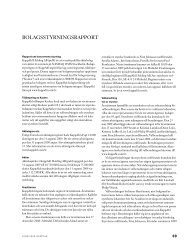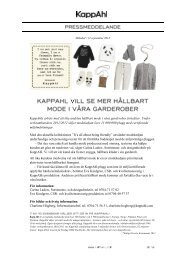We - KappAhl
We - KappAhl
We - KappAhl
Create successful ePaper yourself
Turn your PDF publications into a flip-book with our unique Google optimized e-Paper software.
The financial risks and their management are described in more<br />
detail in Note 22. Risk management is also described in the<br />
corporate governance report, page 72, under the heading<br />
”Report on internal controls”.<br />
A brief description is given below of the most important<br />
identified areas of risk and uncertainty and how <strong>KappAhl</strong> works<br />
with each area of risk.<br />
Competition<br />
The fashion industry is characterised by intense competition, in<br />
terms of both product range and markets. The main competitors<br />
are other chains, department stores, mail order companies and<br />
internet shopping, for the sale of clothes to women, men and<br />
children and of accessories. There is also competition for good<br />
store locations and favourable rental terms. Both Nordic and<br />
international competitors can have greater financial, marketing<br />
or other resources. Consequently they may be better equipped<br />
to adapt to customer demand, to devote more resources to marketing<br />
and design of products and stores or achieve better brand<br />
awareness. Strong competition can lead to price pressure and<br />
falling market share. <strong>KappAhl</strong> focuses on clear concepts and<br />
market positioning through a well-defined target group, combined<br />
with a clear message. This is considered to be a significant<br />
competitive advantage.<br />
Fashion<br />
<strong>KappAhl</strong>’s success is due to its ability to identify and adapt to<br />
constantly shifting fashion trends and customer requirements<br />
and its timely introduction of new and attractive products. The<br />
products must also attract a broad range of customers, whose<br />
perception of fashion cannot be predicted with certainty. If consumer<br />
trends and collections are misread it can lead to a surplus<br />
of certain stock, price cuts and lost sales opportunities. The<br />
brand could be damaged if customers believe that <strong>KappAhl</strong> is<br />
unable to offer them products they perceive as fashionable.<br />
These risks are offset by recruiting talented designers and buyers<br />
who work constantly to spot and predict trends. Moreover the<br />
company has a customer-oriented business model where customer<br />
purchase patterns and behaviour are constantly analysed.<br />
Trade restrictions<br />
Just over two thirds of <strong>KappAhl</strong>’s products are bought in Asia<br />
and the rest are from Europe. Trade restrictions, including<br />
customs tariffs, protective measures or quotas for clothes and<br />
accessories may have an impact on the cost or availability of<br />
products and mean that purchasing routines must be changed. It<br />
is impossible to predict if any of the countries in which clothes<br />
and accessories are manufactured, currently or in the future, will<br />
be subject to further trade restrictions and, if so, what the effects<br />
will be.<br />
Expansion<br />
<strong>KappAhl</strong> is in an intensive phase with extensive expansion of the<br />
store network in all five geographical markets. At the same time,<br />
existing stores are continually being upgraded and extended,<br />
which requires considerable investment and management<br />
resources. There is never any guarantee that investments will<br />
generate sufficient return. Long-term and focused work is<br />
taking place continuously on expanding and reviewing stores to<br />
ensure that expansion targets are realistic and achievable. As at<br />
31 August 2009 there were contracts for 52 new stores.<br />
Trademarks<br />
It is <strong>KappAhl</strong>’s policy to register and protect its brand and name.<br />
There are, however, no guarantees that these measures are sufficient<br />
to protect the brand and property. Moreover, unauthorised<br />
use of the brand on pirate copies or imitation of <strong>KappAhl</strong>’s<br />
stores damage the company’s image and reputation.<br />
Information systems and information security<br />
<strong>KappAhl</strong> relies on information systems to manage the supply<br />
chain from purchase to in store sales as well as to compile operative<br />
and statistical information. The risks include appropriateness of<br />
existing systems and safeguarding business-sensitive information.<br />
Every long stoppage or lack of functionality in the information<br />
systems can mean the loss of important information or delays,<br />
especially if problems occur in the peak season, for example<br />
during the Christmas trade.<br />
Existing systems structures are therefore evaluated on a<br />
continuous basis to ensure that the information systems meet<br />
business requirements. There is also a sharp focus on information<br />
security assurance in all important parts of the Group.<br />
The economy<br />
The industry in which <strong>KappAhl</strong> operates is affected by changes<br />
in the economy that impact total demand and consequently the<br />
level of consumption. Consumer patterns are affected by a<br />
number of general factors beyond the control of the company,<br />
including general business conditions, interest rates, exchange<br />
rates, inflation and deflation levels, taxes, access to credit, stock<br />
market trends, unemployment levels, uncertainty about the<br />
economic outlook for the future and shifts in consumer patterns<br />
from durables to other goods and services. Recent unrest on<br />
financial markets has had a dampening effect on consumption.<br />
For <strong>KappAhl</strong>, however, this may be a business opportunity, as<br />
our customer offer gives a lot of value for money.<br />
2008/2009 Kappahl financial information 37





